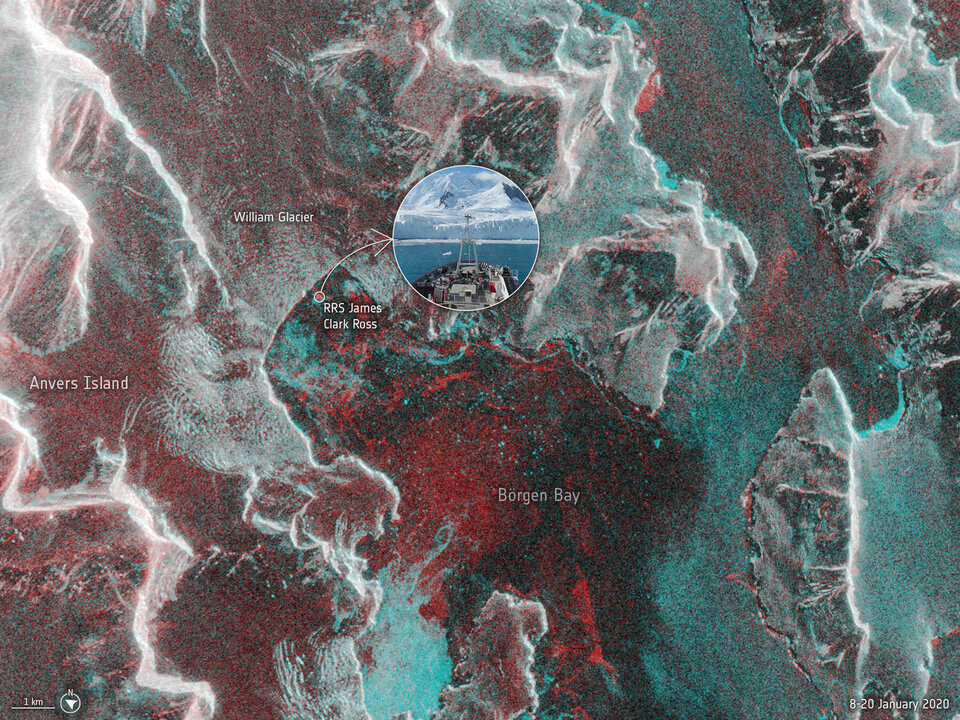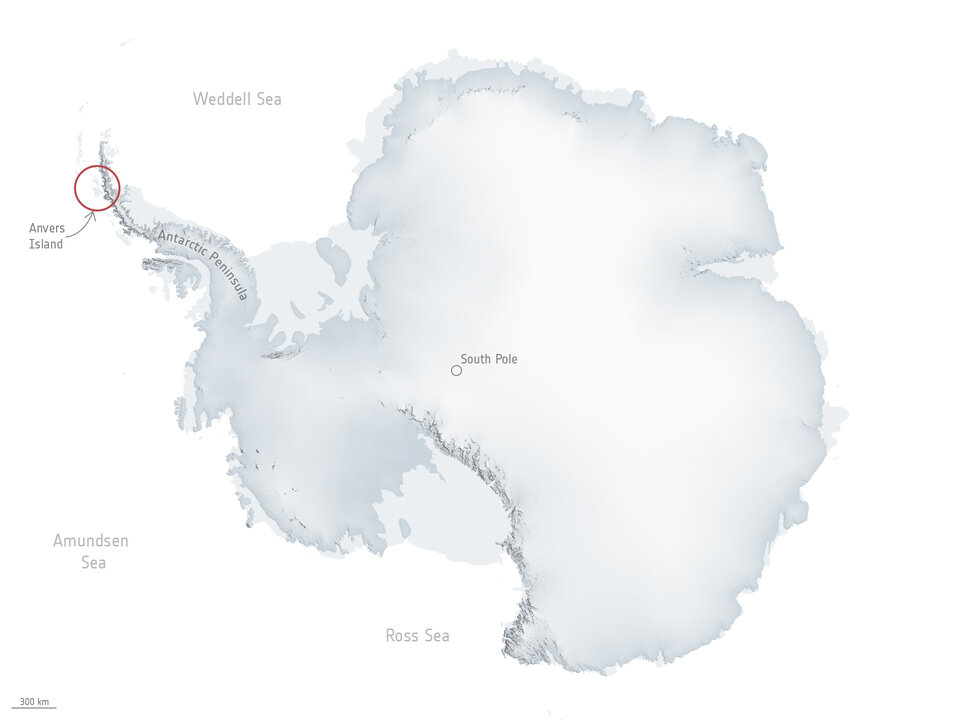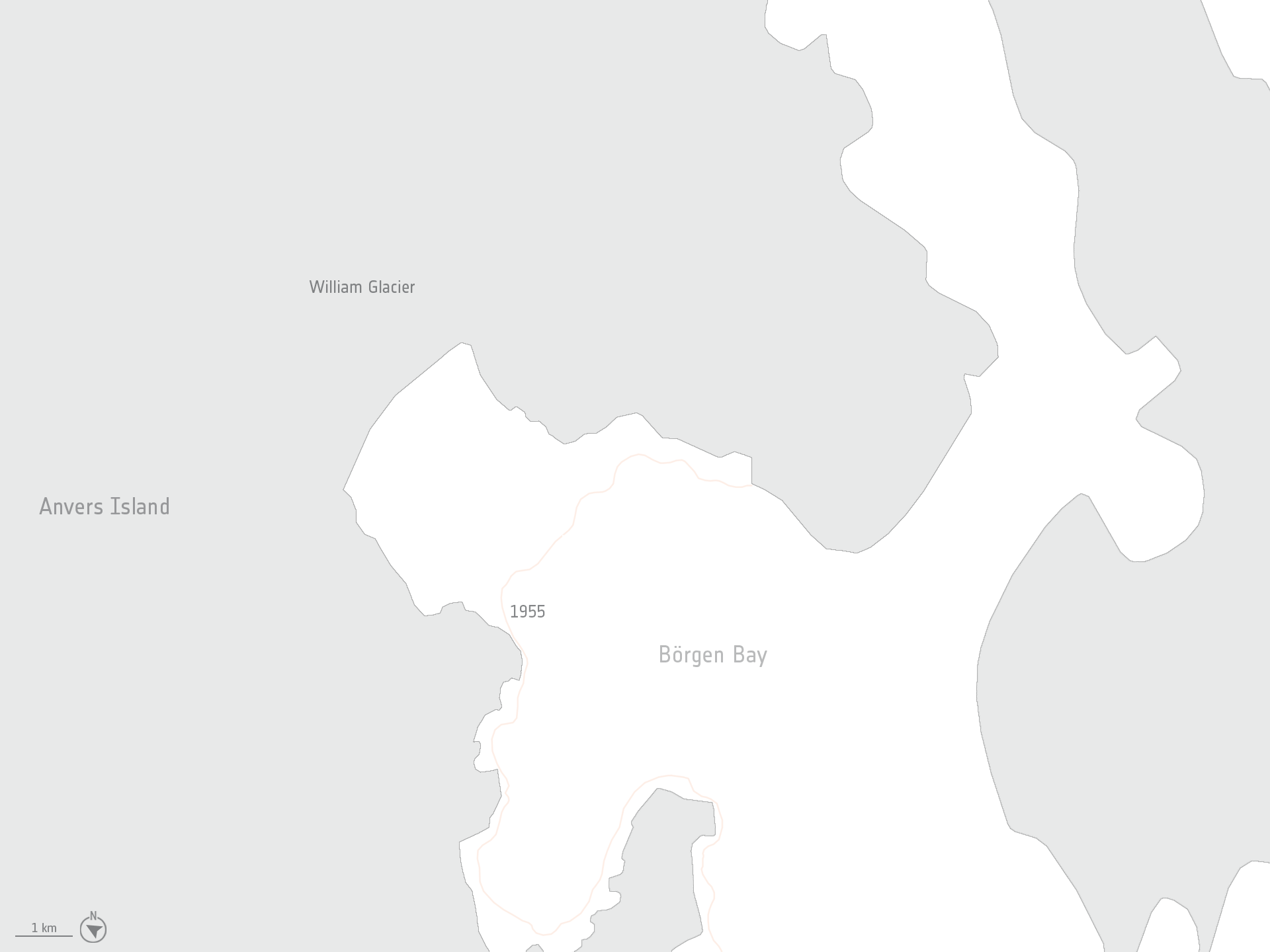Published on 29 November 2022
A team aboard the British Antarctic Survey’s RRS James Clark Ross research ship was taking ocean measurements off the Antarctic Peninsula in January 2020 when the front of the William Glacier disintegrated into a thousand small pieces before their very eyes.
William Glacier calving
Remarkably, one of Europe’s Copernicus Sentinel-1 satellites passed overhead while the ship was close to the Peninsula and captured a radar image.
The image below combines two Sentinel-1 images: one from 8 January 2020 and one from 20 January 2020 when the ship was in the bay, appearing as a red dot. The image captures the William Glacier and Börgen Bay, but more importantly the red colours depict where the sea and ice surfaces changed between the two dates, while white indicates no change.
The amount of red clearly indicates the dynamic nature of the region, and the crevices and fractures on the edge of the glacier front are clear to see.

Research ship seen by Sentinel-1
As well as witnessing the iceberg calving and the resulting waves on the ocean surface, the team on the ship recorded ‘internal’ underwater tsunami waves as tall as a house. This phenomenon that has been missed in the understanding of ocean mixing and in computer models.
Internal tsunami waves are an important factor in ocean mixing, which affects marine life, temperatures at different depths, and how much ice the ocean can melt.
Ice in Antarctica flows to the coast along glacier-filled valleys. While some ice melts into the ocean, a lot breaks off into icebergs, which range from small chunks up to slabs the size of a country.
The William Glacier typically has one or two large calving events a year. With the front of the glacier towering 40 m above sea level, the team estimated that this event broke off around 78,000 square metres of ice – around the area of 10 football pitches.
Before the glacier front disintegrated, the ocean water at the depth of 50–100 m was cool but there was a warmer layer beneath this. After the calving, this changed dramatically, with the temperature much more even across different depths.

William Glacier lies on the Antarctic Peninsula
Over the following months, scientists set about analysing the data, which culminated in their research being published recently in Science Advances.
Michael Meredith, lead author and head of the Polar Oceans team at the British Antarctic Survey, said, “This was remarkable to see, and we were lucky to be in the right place at the right time.
“Lots of glaciers end in the sea, and their fronts regularly split off into icebergs. This can cause big surface waves, but we know now that it also creates waves inside the ocean. These internal waves cause the sea to mix, and this affects life in the sea, how warm it is at different depths and how much ice it can melt.
“Ocean mixing influences where nutrients are in the water and this matters for ecosystems and biodiversity.
Simulation: underwater tsunami temperature mixing
“We thought we knew what caused this mixing – in summer, we thought it was mainly down to winds and tides, but it never occurred to us that iceberg calving could cause internal tsunamis that would mix things up so substantially.”
As opposed to the waves caused by wind and tides, tsunamis are caused by geophysical events where water is suddenly shifted, for example by an earthquake or landslide. Internal tsunamis have been noticed in a handful of places, caused by landslides.
Until now, no one had noticed that they are happening around Antarctica, probably all the time because of the thousands of calving glaciers there. Other places with glaciers are also likely to be affected, including Greenland and elsewhere in the Arctic.
This chance observation and understanding is important since glaciers are set to retreat and calve more as climate change continues. This could likely increase the number of internal tsunamis and the mixing they cause.
This process is not factored into current computer models enabling the team to predict what might happen around Antarctica. This discovery changes our understanding of how the ocean around Antarctica is mixed and will improve knowledge about what this means for our climate, the ecosystem and sea-level rise.
Prof. Meredith concludes, “Our fortuitous timing shows how much more we need to learn about these remote environments and how they matter for our planet.”
William Glacier lies on the Antarctic Peninsula
Glaciers around the world are generally retreating – a serious consequence of climate change. The image below shows how the William Glacier has retreated since 1955, roughly 3 km in all. The last two retreat lines, 2016 and 2021, are based on Copernicus Sentinel-1 satellite data, and the very early years, before the advent of the satellite era, are based on aerial observations.
Source:
Glacier calving and a whole lot of mixing. (n.d.). https://www.esa.int/Applications/Observing_the_Earth/Copernicus/Sentine…

